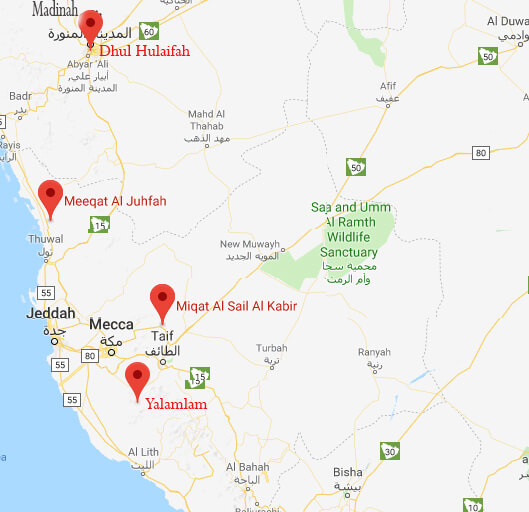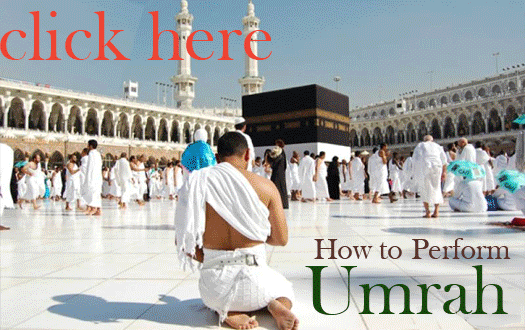Meeqath for Hajj and Umrah
What is Meeqat? Well, Meeqat is a point appointed for starting an umrah. Meeqat means a stated place. A pilgrim should be In the state of ihram before passing the Meeqat point. There are Five Meeqat points appointed by the Prophet Muhammad.
- Dhu'l-Hulayfah - Dhu'l-Hulayfah is the mīqāt for those who live in Madinah, and for those who approach Mecca from the direction of Madinah.
- Juhfah - This is the mīqāt for the people who come from the direction of Syria.
- Qarn ul-Manāzil - serves pilgrims coming from the Najd region, which is generally the middle of Saudi Arabia. If you are approaching from the direction of Qatar, UAE Bahrain, Oman or Kuwait via Qarn ul-Manāzil will be your Meeqat point.
- Yalamlam - This Mīqāt point serves the Pilgrims coming from the direction of Yemen.
- Dhāt-i 'Irq - This Mīqāt serves pilgrims coming from the direction of Iraq, Iran, and other places en route.
"Muslims coming to Makkah with the intention of performing Umrah or Hajj must not cross a Miqat without first entering into the state of Ihram, unless they live within the area between Miqat and the Haram. In this case they do Ihram either at home or just before entering the Haram area."

Dhu'l-Hulayfah
This Meeqat is about 9 kilometres from Madinah and roughly 450 kilometres to Makkah. Dhu'l-Hulayfah is the Meeqat for those who live in Madinah and for those who approach Makkah from the direction of Madinah. Masjid Bir Ali is located in this place so whoever willing to pray or shower or change clothes you may do it in this masjid. This masjid has showering facilities.
Juhfah
Juhfah is the meeqat for the pilgrims who are coming from the direction of Syria. It is located about 190km northwest of Makkah.
Qarn ul-Manāzil
Qarn Al Manazil is 85km from Makkah, it is the Meeqat for the pilgrims who are travelling from Riyadh, Dammam, Dubai, Abu Dhabi, Sharjah, Fujairah, Ras al Khaimah, Bahrain Kuwait and Oman.
Yalamlam
Yalamlam is the Meeqath point for the pilgrims coming from the direction of Yemen. Yalamlam is a small city in the province of Makkah.
Dhāt-i 'Irq
Dhaat-I irq is the Meeqat for the pilgrims travelling from Iran and Iraq. It is located about 85 kilometres (53 mi) northeast of Makkah.
Meeqath Boundary for people in Makkah
Meeqat boundary for the people who are in Makkah will be Masjid Al Tanheem. Masjid Al Tanheem is also known as Aisha masjid. If you are already staying in Makkah, you have to go to Aisha Masjid and assume ihram from there. Read this article to know about Aisha Masjid. If you are going to perform a second umrah read “how to perform second Urmah”.
Meeqat for the Pilgrims Flying to Jeddah
If you are flying to Jeddah, you must enter the state of Ihram before you reach the Meeqat zone. Since Jeddah is already in the Meeqat zone, your umrah will be not valid if you arrive in Jeddah without wearing Ihram. The Pilots will announce about the Meeqat zone 30 minutes before, entering the Meeqat zone. So, you have 30 minutes to wear Ihram. You might have to use the Aircraft lavatory to change.
If you travel with the Airliners operated by non-Muslims, this announcement may not be available. So, it is advisable to wear Ihram At the departing Airport. Please check with the airline operators.
Al-Hil Area
Al-Hil refers to the area between the boundaries of the Mawaqit and the boundaries of the Haram. Towns and cities such as Jeddah, Khulais, al-Janun, and Taneem are all situated within al-Hil. So a person who resides in Al hil area may assume ihram by existing the Haram boundary, if he/she wish to perform umrah. The same rule applies for a person who visited Al hil area for any other purpose other than umrah or hajj.
Travelling to Jeddah or Makkah (Al hil Area) for any other purpose other than umrah
If you are travelling to Makkah or Jeddah for any other purpose other than umrah you don’t have to wear ihram. But if you decided to perform umrah after finishing your business, then you must exit the boundary of the haram and then Assume ihram. You may find the closet point assume ihram.
The haram of Makkah and its boundary
Haram is a sacred area of Makkah. Some of the lawful acts in Islam is prohibited inside the haram area. It is forbidden to hunt wild animals, damage any plant or tree, graze animals, carry weapons, fight, or behave in a manner that will violate the sanctity of Masjid al-Haram. If a person violates within the precinct of the Haram, Damm or Sadaqah is required as expiation.
If a violation is carried out within the precinct of the Haram, an animal sacrifice (damm) or gift of charity (sadaqah) is required as expiation.
The boundaries of the Haram are the following:
- Taneem – Masjid Aisha, also known as Masjid Taneem, located about 8 kilometres (5.0 mi) from the Kaaba and 5 kilometres (3.1 mi) away from Mecca, in the direction of Madinah. Read about Masjid Aisha.
- Adaat Laban – On the road to Yemen, 11 kilometres (6.8 mi) away from Mecca.
- Wadi Nakhla – On the road to Iraq, 11 kilometres (6.8 mi) away from Mecca.
- Arafat – On the road to Ta'if, close to Masjid al-Namirah in Arafat, 11 kilometres (6.8 mi) away from Makkah.
- Ji'ranah – Masjid al-Ji'ranah, located about 14 kilometres (8.7 mi) away from Mecca.
- Hudaibiyah – Masjid al-Hudaibiyah, on the road to Jeddah, about 16 kilometres (9.9 mi) away from Makkah.
Hadeeth about Meeqat
There are five Miqats in total, four of which are mentioned in the following Hadith narrated by Abdullah ibn Abbas I:
Allah’s Messenger ﷺ had fixed Dhul Hulayfah as the Miqat for the people of Madinah; al-Juhfah for the people of Sham; and Qarn al-Manazil for the people of Najd; and Yalamlam for the people of Yemen. So, these (above mentioned) are the Mawaqit for all those living in those places, and besides them for those who come through those places with the intention of performing Hajj and Umrah and whoever lives within these places should assume Ihram from his dwelling place, and similarly the people of Makkah can assume Ihram from Makkah.
[Narrated in Sahih al-Bukhari]
An additional Miqat was affixed during the reign of the second caliph, Umar Ibn al-Khattab I after the towns of Basra and Kufa had been captured. Abdullah ibn Umar I narrates:
When these two towns (Basra and Kufa) were captured, the people went to Umar and said, “O Chief of the faithful believers! The Prophet ﷺ fixed Qarn as the Miqat for the people of Najd, it is beyond our way and it is difficult for us to pass through it.” He said, “Take as your Miqat a place situated opposite to Qarn on your usual way. So, he fixed Dhat Irq (as their Miqat).
[Narrated in Sahih al-Bukhari]
references:
http://www.hajinformation.com/main/e101.htm
https://www.al-feqh.com/en/al-mawaqeet#ix0
- (ﷺ)- (salallahu Alai wasallam)- May Allah's peace and blessings be upon him
- رضي الله عنه (Radhiallahu’ Anhu) - May Allah be pleased with him
- عليه السلام (Alaihi Salam) - Peace be upon him
For business inquiries: myumrahguide@gmail.com
Recent Articles
-
Performing Umrah with children
May 05, 22 10:04 AM
Performing Umrah with children or infants are full of challenges. -
Umrah for woman - Ladies special Edition written for ladies only
Apr 17, 22 05:57 AM
umrah for woman is not like umrah for men, there are some differences. This Article briefs all the concerns of lady during her Umrah. -
Masjid Suqya and saqya well - Masjid As Suqya
Apr 08, 22 04:36 PM
Masjid Suqya is where the prophet Muhammad PBUH, prayed and supplicated for residents of Madinah and then marched to the battle of badr.




New! Comments
Have your say about what you just read! Leave me a comment in the box below.